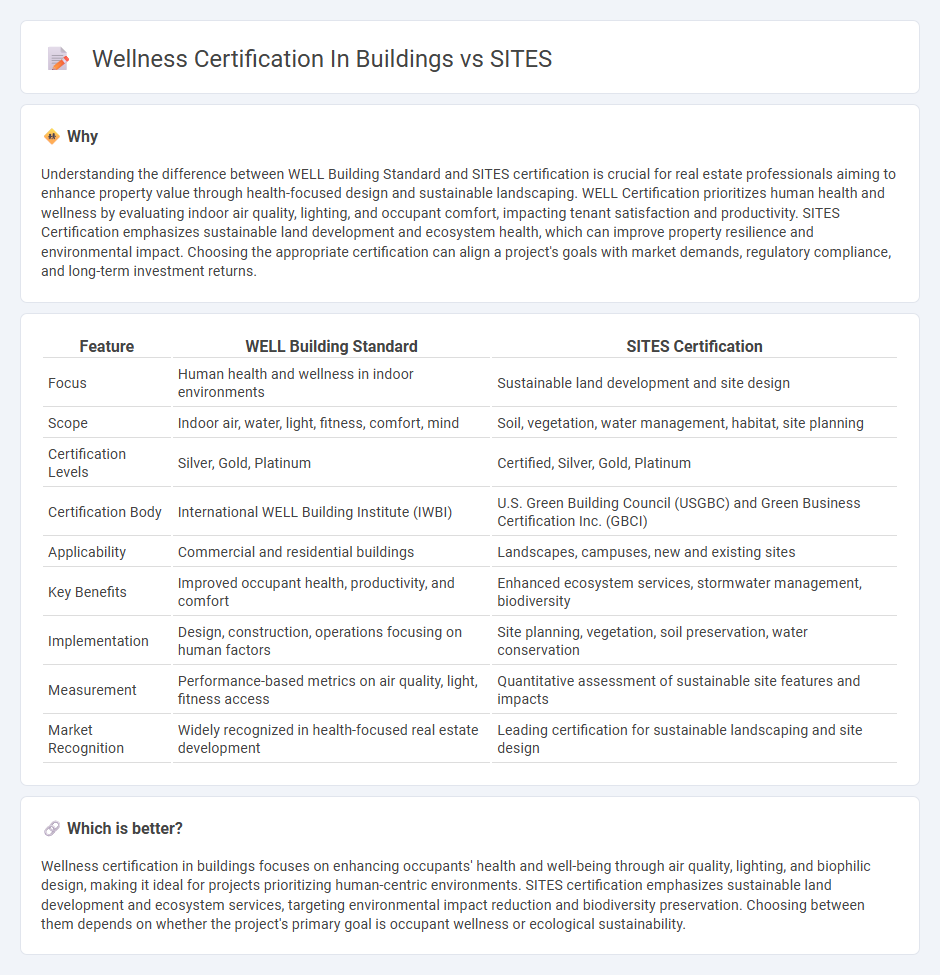
Wellness certification in buildings focuses on enhancing occupant health, comfort, and productivity through standards like air quality, lighting, and ergonomics, while SITES certification emphasizes sustainable land development and ecological resilience in landscapes. Both certifications contribute to environmental and human well-being but target different aspects of real estate development. Explore how integrating these certifications can maximize value and sustainability in your next project.
Why it is important
Understanding the difference between WELL Building Standard and SITES certification is crucial for real estate professionals aiming to enhance property value through health-focused design and sustainable landscaping. WELL Certification prioritizes human health and wellness by evaluating indoor air quality, lighting, and occupant comfort, impacting tenant satisfaction and productivity. SITES Certification emphasizes sustainable land development and ecosystem health, which can improve property resilience and environmental impact. Choosing the appropriate certification can align a project's goals with market demands, regulatory compliance, and long-term investment returns.
Comparison Table
| Feature | WELL Building Standard | SITES Certification |
|---|---|---|
| Focus | Human health and wellness in indoor environments | Sustainable land development and site design |
| Scope | Indoor air, water, light, fitness, comfort, mind | Soil, vegetation, water management, habitat, site planning |
| Certification Levels | Silver, Gold, Platinum | Certified, Silver, Gold, Platinum |
| Certification Body | International WELL Building Institute (IWBI) | U.S. Green Building Council (USGBC) and Green Business Certification Inc. (GBCI) |
| Applicability | Commercial and residential buildings | Landscapes, campuses, new and existing sites |
| Key Benefits | Improved occupant health, productivity, and comfort | Enhanced ecosystem services, stormwater management, biodiversity |
| Implementation | Design, construction, operations focusing on human factors | Site planning, vegetation, soil preservation, water conservation |
| Measurement | Performance-based metrics on air quality, light, fitness access | Quantitative assessment of sustainable site features and impacts |
| Market Recognition | Widely recognized in health-focused real estate development | Leading certification for sustainable landscaping and site design |
Which is better?
Wellness certification in buildings focuses on enhancing occupants' health and well-being through air quality, lighting, and biophilic design, making it ideal for projects prioritizing human-centric environments. SITES certification emphasizes sustainable land development and ecosystem services, targeting environmental impact reduction and biodiversity preservation. Choosing between them depends on whether the project's primary goal is occupant wellness or ecological sustainability.
Connection
Wellness certification in buildings focuses on enhancing occupant health and well-being through design, air quality, and access to natural light, aligning closely with SITES certification, which emphasizes sustainable land development and ecosystem health. Both certifications integrate green building principles that promote environmental stewardship and create healthier, more resilient living spaces. Combining wellness certifications with SITES standards supports holistic real estate projects that prioritize human health alongside ecological sustainability.
Key Terms
Sustainable Landscaping
SITES certification emphasizes sustainable landscaping practices by promoting soil health, native plant selection, and efficient water management to enhance ecosystem services and biodiversity. WELL certification focuses on the impact of landscaping on occupant health and well-being, including air quality improvement, stress reduction, and access to nature. Discover how integrating SITES and WELL standards can maximize the environmental and health benefits of sustainable landscaping in your building projects.
Indoor Environmental Quality
SITES certification emphasizes sustainable site development, prioritizing reducing environmental impact through green infrastructure and landscape performance, while wellness certification targets occupant health by enhancing Indoor Environmental Quality (IEQ) factors such as air quality, lighting, and thermal comfort. IEQ improvements under wellness standards include advanced ventilation systems, low-emission materials, and circadian lighting to promote productivity and well-being. Discover how integrating SITES and wellness certifications can optimize both environmental sustainability and human health in building design.
Human Health and Well-being
SITES certification prioritizes sustainable land development and ecosystem health, integrating green infrastructure to enhance environmental quality and outdoor human well-being. Wellness certifications, such as WELL, specifically target indoor environmental quality, air and water quality, lighting, and occupant health to optimize human comfort and productivity within buildings. Explore these certifications further to understand how they collectively contribute to holistic well-being in the built environment.
Source and External Links
SITES | Developing Sustainable Landscapes - SITES is a rating system that guides, evaluates, and certifies sustainability in landscape planning, design, construction, and management, supporting nature-based solutions to enhance biodiversity and mitigate climate change.
SITES rating system - SITES offers a comprehensive framework for designing and managing sustainable landscapes worldwide, with a 200-point rating system and four certification levels that complement LEED for buildings.
Google Sites - Google Sites is a free, easy-to-use drag-and-drop website builder designed for collaboration and quick publishing with real-time co-editing and fast page loading.
 dowidth.com
dowidth.com